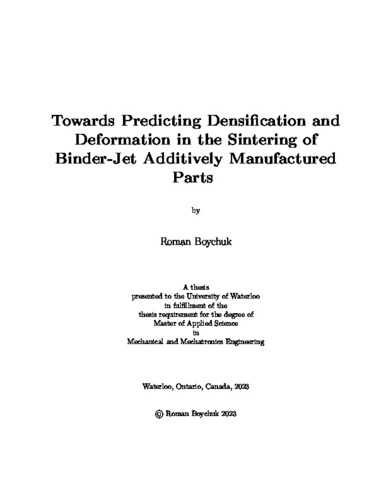UWSpace will be migrating to a new version of its software from July 29th to August 1st. UWSpace will be offline for all UW community members during this time.
Towards Predicting Densification and Deformation in the Sintering of Binder-Jet Additively Manufactured Parts
| dc.contributor.author | Boychuk, Roman | |
| dc.date.accessioned | 2023-04-10 16:32:12 (GMT) | |
| dc.date.available | 2024-04-10 04:50:03 (GMT) | |
| dc.date.issued | 2023-04-10 | |
| dc.date.submitted | 2023-03-23 | |
| dc.identifier.uri | http://hdl.handle.net/10012/19262 | |
| dc.description.abstract | Binder-jet additive manufacturing (BJAM) is a three-dimensional (3D) printing process which produces parts from successive layers of a powder material (typically metal or ceramic) and selective jetting of a liquid binder to join particles together in each layer. These parts are subsequently exposed to heat treatment steps to remove the binder (de-binding stage) and fuse the particles together (sintering stage) into a final part. During this sintering process, the part experiences shrinkage as the voids between powder particles are eliminated, and can experience distortion due to softening at high temperatures close to the melting point of the material. In this thesis, a modified version of the Skorohod-Olevsky viscous sintering (SOVS) model is presented to model the densification and deformation of samples printed from gas-atomized 4340 low-alloy steel during solid-phase sintering. First, a lumped form of the model is considered for modeling the densification of samples inside a push-rod dilatometer, and trained on one of the data sets. The fitting of the model to the experimental data is done using a derivative-free global optimization approach -- the data-based online nonlinear extremumseeker (DONE) algorithm. The resulting optimized model obtains density prediction errors of at most 3% on the training data, but expectedly experiences greater errors when applied to different heating rates. The modified SOVS model is then implemented in 3D within COMSOL Multiphysics software, and used to predict the densification and deformation of printed 4340 artifacts. The artifacts were sintered inside an optical dilatometer furnace, and the contour data extracted from these experiments was used to train and validate the 3D sintering model using the same optimization approach. The resulting optimized model could predict contour errors within 0.3mm on the training data, and 1.4mm and 0.7mm for validation samples, all with a characteristic length of 20mm. The results show good contour prediction performance, despite the relatively simple nature of the modified SOVS model used in this work, and establishes a basis for further sintering modeling using in-situ thermo-optical measurements. | en |
| dc.language.iso | en | en |
| dc.publisher | University of Waterloo | en |
| dc.subject | sintering | en |
| dc.subject | simulation | en |
| dc.subject | optical dilatometry | en |
| dc.subject | optimization | en |
| dc.subject | binder jetting | en |
| dc.subject | 3D printing | en |
| dc.title | Towards Predicting Densification and Deformation in the Sintering of Binder-Jet Additively Manufactured Parts | en |
| dc.type | Master Thesis | en |
| dc.pending | false | |
| uws-etd.degree.department | Mechanical and Mechatronics Engineering | en |
| uws-etd.degree.discipline | Mechanical Engineering | en |
| uws-etd.degree.grantor | University of Waterloo | en |
| uws-etd.degree | Master of Applied Science | en |
| uws-etd.embargo.terms | 1 year | en |
| uws.contributor.advisor | Vlasea, Mihaela | |
| uws.contributor.advisor | Ghavam, Kamyar | |
| uws.contributor.affiliation1 | Faculty of Engineering | en |
| uws.published.city | Waterloo | en |
| uws.published.country | Canada | en |
| uws.published.province | Ontario | en |
| uws.typeOfResource | Text | en |
| uws.peerReviewStatus | Unreviewed | en |
| uws.scholarLevel | Graduate | en |

